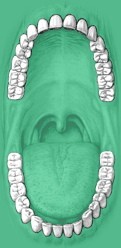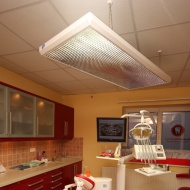Dental extraction is performed for a variety of reasons, tooth decay that has destroyed enough tooth structure to prevent restoration is the most frequent, and extraction of permanent teeth to make space for orthodontic treatment is also common.
Simple extractions are performed on teeth that are visible in the mouth, usually under local anesthetic. Surgical extractions involve the removal of teeth that cannot be easily accessed, either because it is broken under the gum line or it has not erupted fully.
Removal of teeth is sometimes necessary because of pain, infection, bone loss or fracture of the tooth. The bone that holds the tooth in place (the socket) is often damaged by disease and/or infection resulting in deformity of the jaw after the tooth is extracted. In addition, when teeth are extracted, the surrounding bone and gums can shrink and recede very quickly after the extraction resulting in unsightly defects and collapse of the lips, and cheeks.
These jaw defects can create major problems in performing restorative dentistry whether your treatment involves dental implants, bridges or dentures. Jaw deformities from tooth removal can be prevented and repaired by a procedure called socket preservation. Socket preservation can greatly improve your smile’s appearance and increase your chances for successful dental implants for years to come.
Socket Preservation procedure prevents immediate bone resorption after extraction thus keeping the contour and integrity of the socket with successful and natural looking appearance for tooth restorative procedures. All dental prosthesis requires good jaw bone support for it to be successful in the long run. Without socket preservation, residual bones could lose volume resulting in loss of facial vertical and horizontal dimension and changes in facial soft tissues aesthetics.
Several techniques can be used to preserve the bone and minimize bone loss after an extraction. In one common method, the tooth is removed and the socket is filled with bone or bone substitute. It is then covered with gum, artificial membrane, or tissue stimulating proteins to encourage your body’s natural ability to repair the socket. With this method, the socket heals eliminating shrinkage and collapse of surrounding gum and facial tissues. The newly formed bone in the socket also provides a foundation for an implant to replace the tooth. If your dentist has recommended tooth removal, be sure to ask if socket preservation is necessary. This is particularly important if you are planning on replacing the front teeth.
Bleeding after tooth extraction
There are cases, when bleeding seems not to stop as quickly as one could expect. Bleeding in the oral cavity has a unique feature: as blood dissolves in the saliva and become diluted, looks to be much more than it really is.
Some oozing of blood from the tooth extraction site could be quite normal and no special measures are necessary.
If there is prolong oozing or bleeding, than make a small roll or ball from gauze, place it over the extraction site and bite firmly on it. Keep the gauze roll (ball) in place for 20 minits at least.
The process can be repeated again, if necessary.
For your reassurance
Biting on a gauze roll (compression) is one of the most effective ways to control bleeding. If you apply this method, you are on the best way to stop bleeding. If there is no special reason for bleeding, you applying the right method. As for special reasons, there are general diseases or medicines for general diseases (anticoagulant medicines) that have effect on blood coagulation. If this is the case, it is better to inform your doctor about it.
After the tooth extraction:
- 3-4 hour after the surgery - or until the numbness goes away-, try to drink just liquid. For 1-2 days try to avoid those foods and drinks which contain coffee, milk or egg. Until the stitch removal, eat pulpy foods. Try to chew on the opposite site of the surgery.
- Smoking and drinking alcohol is avoidable until the stitches will be removed, because of the possibility of the infection and bleeding of the wound.
- After the surgery it is recommended to keep intensified mouth hygiene. Wash your teeth more often during the day and after every meal with a soft toothbrush. From the day of the surgery it is expedient to use chamomile and/or antiseptic mouth rinse.
- After the surgery ice your face as soon as possible. For this, the best is to use ice, or for example you can freeze a bag of milk and fold it in a towel or a dry cloth and push it to your operated side of your face from outside.
- Please try to avoid sucking the operated area. The following day of the surgery avoid the flushing of the mouth, touching the wound with your hand or any other tools.
- Until the stitch removals try to avoid the physical work and sleep on a high pillow.
- Use your medicine, pills according to your doctor’s instructions.
- In every case we will give you information of the appointment of the stitch removal. Usually this takes place one week later after the surgery, except those who had sinus closure during surgery.
- Those patients who had sinus closure during surgery follow these advices. Also strictly avoid blowing the nose, strain and sneeze with an open mouth. In these cases the stitch removal usually takes place on the tenth day after the surgery.




